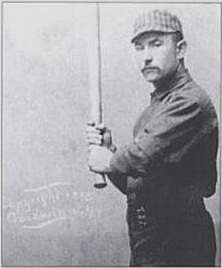Oyster Burns facts for kids
Quick facts for kids Oyster Burns |
|||
|---|---|---|---|
 |
|||
| Outfielder | |||
| Born: September 6, 1864 Philadelphia, Pennsylvania |
|||
| Died: November 11, 1928 (aged 64) Brooklyn, New York |
|||
|
|||
| debut | |||
| August 18, 1884, for the Wilmington Quicksteps | |||
| Last appearance | |||
| September 16, 1895, for the New York Giants | |||
| Career statistics | |||
| Batting average | .300 | ||
| Runs batted in | 832 | ||
| Stolen bases | 263 | ||
| Home runs | 65 | ||
| Teams | |||
|
|||
| Career highlights and awards | |||
|
|||
Thomas P. "Oyster" Burns (born September 6, 1864 – died November 11, 1928) was an American baseball player. He played for 11 Major League Baseball (MLB) seasons. Burns was known for his strong batting average of .300. He hit 65 home runs and had 834 runs batted in (RBI).
He played for teams like the Wilmington Quicksteps, Baltimore Orioles, Brooklyn Bridegrooms, and New York Giants. Burns mostly played as an outfielder. He also played other positions like shortstop and second baseman. He was nicknamed "Oyster" because he sold oysters when he wasn't playing baseball. People described him as a "loudmouth" with a strong personality.
Contents
Early Life and Start in Baseball
Burns was born on September 6, 1864, in Philadelphia, Pennsylvania. His parents, Patrick and Mary Burns, came to the United States from Ireland.
Starting His Professional Career
In 1883, Burns began his professional baseball journey. He started as a pitcher for a minor league team in Harrisburg, Pennsylvania. In his first year, he had a good earned run average (ERA) of 2.30. When he wasn't pitching, Burns played second and third base.
Playing in Major League Baseball
Burns joined the Wilmington Quicksteps in 1884. Later that year, he moved to the Baltimore Orioles. At just 18 years old, he was the youngest player on the Orioles team. Even though he played in only 35 games, he hit six home runs. This was more than any other player on his team that season.
In 1885, his batting average was .231. He also had five home runs and 37 RBIs. Because his batting average was a bit low, he played for a minor league team in 1886. Burns helped that team win their league championship. By 1887, he was back in the major leagues with the Orioles. He even became the team's captain for a short time.
Moving to the Brooklyn Bridegrooms
After playing 79 games for Baltimore, Burns moved to the Brooklyn Bridegrooms. The owner of both teams, Harry Von der Horst, made this move. While playing for the Bridegrooms, a newspaper called the New York Clipper said Burns was "the noisiest man" on the team.
In 1889, Burns had the highest batting average and most home runs for the Bridegrooms. That year, the Bridegrooms won the American Association championship. They played against the New York Giants in the World Series. Burns hit a three-run home run to help his team win one game. However, the Giants ended up winning the series.
Leading the League
In 1890, the Bridegrooms joined the National League. Burns, who was 26, had an amazing year. He led the entire league in home runs with 13. He also led the league in RBIs with 128. On August 1, 1890, he achieved a rare feat: he hit for the cycle. This means he hit a single, double, triple, and home run all in the same game. He was the first Bridegroom player to do this.
The Bridegrooms won the National League championship that year. In the 1890 World Series, they played against the Louisville Colonels. The series ended in a tie because of bad weather.
In 1892, the team changed its name to the Grooms. Burns continued to be a strong player. His RBI total was the third highest in the league. His hits, doubles, triples, and batting average were also among the best on the Brooklyn team. Burns played for the club until 1895. He then played his final MLB season with the New York Giants. In his last year in the major leagues, he batted .258 over 53 games.
Playing in Minor Leagues Again
After 1895, Burns played for minor league teams. He played for the Newark Colts, who won their division. The next season, he was a player-coach for the Hartford Bluebirds. He led that team in doubles and batting average. He later coached for another minor league team in Portland, Maine.
Life After Baseball
After he stopped playing baseball, Oyster Burns lived in Brooklyn. He passed away on November 11, 1928. He was buried in Holy Cross Cemetery in North Arlington, New Jersey.


